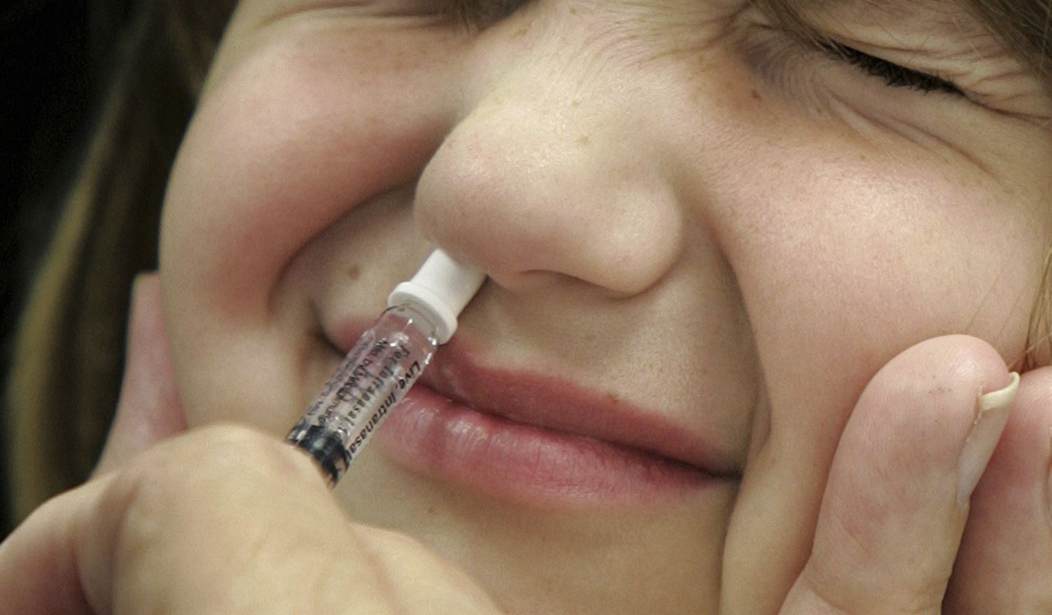What exactly are we to make of the stunning decline in influenza cases we’re seeing this season?
Phil Kerpen has been compiling the CDC’s data, and remarkable doesn’t even begin to describe it.
By the sixth week of last year, around 32% of the roughly 57,000 flu tests reported to the CDC had come back positive. And these numbers are in line with those from the previous four years as well:
- In 2019, around 40,000 influenza tests were reported by week six, with roughly 26% positive.
- From 2016 thru 2020, an average of around 44,000 influenza tests had been reported by week six, roughly 25% of which were positive
Yet, by the sixth week of 2021, CDC figures show that only 17 of the over 40,800 reported flu tests reported to the CDC this year were positive, which comes to a minuscule .04%!
If these numbers are to be believed, influenza cases have declined by a factor of over 600 this year compared to the previous five-year average.
For all intents and purposes, the flu appears to have vanished.
United States Influenza testing, MMWR week 6.
CDC flu view. https://t.co/Ab9nuRIz5U
Five-year average: 12,066 cases; 25.38% positive
Last year: 18,193; 31.96%
This year: 17; 0.04%https://t.co/0EHy5xEFm0 pic.twitter.com/WNGzigMaMf— Phil Kerpen (@kerpen) February 19, 2021
And it’s not just in America either.
British news outlet, the Independent just reported that not a single one of the almost 700,000 influenza tests reported in England so far this year has come back positive!
On one hand, COVID continues to spread because of COVID law disobedience.
On the other, flu disappears because NPI compliance is so high.
— Aaron Ginn (@aginnt) February 24, 2021
The “head of flu” at England’s Public Health department, Dr. Vanessa Saliba, attributes the vanishing flu to the stringent measures her country adopted against COVID-19.
The decrease in flu cases this year is likely due to changes in our behaviour, such as social distancing, face coverings and handwashing, as well as the reduction in international travel.
But if Dr. Saliba said anything about why this is the right explanation, the Independent neglected to mention it.
Nor did they explain why, in their subheader, they chose to leave out Dr. Saliba’s “likely” qualifier and straightforwardly attribute the decline in flu cases to England’s draconian COVID-19 restrictions: Not a Single Case of Flu Detected by Public Health England This Year as COVID Restrictions Suppress Virus.
And, of course, nothing in the Independent piece explains how it’s even remotely possible that the COVID-19 restrictions could have so effective against the flu that they completely eliminated it this year, yet so ineffective against COVID-19 itself that England has already seen over 1.6 million reported cases since January 1.
M.G. Sunde, writing at Medium, has given a very nice summary of the many reasons it’s grossly implausible that the restrictions adopted against COVID-19 wound up inadvertently ridding us of the flu.
- For one thing, given that “SARS-CoV-2 virions[…] are similar in size to those of influenza,” Sunde notes that:
If the wearing of masks was capable of almost entirely removing influenza from circulation[…] then this approach would also eliminate SARS-CoV-2.
- Even more tellingly, however:
The reduction (or more accurately disappearance) in influenza cases has occurred in all geographic regions, regardless of the nonpharmaceutical interventions (NPIs) that have been employed.
Sunde gives a number of other reasons as well. But the fact that the flu seems to have vanished all around the world regardless of whether and to what extent COVID-19 restrictions were implemented should be sufficient to rule them out as the culprit.
Sunde goes on to suggest an alternative explanation of his own, however.
Namely, that “a biological process, whereby viruses engage in some form of competition” with each other is responsible, and, hence, that COVID-19 itself, rather than our reaction to it, is what vanquished the flu. He also cites some research papers indicating that such competition between viruses might actually occur.
It’s possible that Sunde’s explanation is correct. Maybe COVID-19 beat out the flu and that’s why the latter has for all intents and purposes disappeared.
But a sharp-eyed Twitter user named Darren Dunn has suggested a much more mundane explanation, which—apart from being at least as likely—also points to the manifest absurdity of drawing any kind of firm conclusions from the kind of data we’re being fed.
It appears that the window for detecting influenza viruses using the standard PCR-type test may be incredibly small. So small that—if the huge influx of COVID-19 tests labs have been dealing with caused any kind of delay in how quickly influenza tests were processed—that by itself could easily explain why basically all of the latter are coming back negative.
It’s possible by prioritizing #COVID19 testing you are pushed outside the detection window of Influenza.
By arranging a test, waiting for results (receive your negative) then booking an appointment at a Dr.s office you’d be beyond the detection window by the time you were tested pic.twitter.com/Vzzs7jHtxH
— Darren Dunn (@ImDarrenDunn2) October 19, 2020
The chart in Dunn’s post comes from a paper that looked at 50 patients hospitalized with flu-symptoms who tested positive for influenza and then had a follow-up test on the 3rd, 5th, and 7th subsequent day. Some of the patients were released each day, so not all 50 of them wound up getting every follow-up test.
But, as you can see, the results are, nonetheless, striking.
Just seven days after that first positive test, a full 80% of patients wound up testing negative for influenza. And that’s true even though their symptoms were still serious enough to keep them in the hospital and participating in the study.
So, as Dunn notes, given (i) the massive influx of COVID-19 tests labs are doing this year, (ii) the further likelihood that they’re being prioritized, and (iii) the fact that it will take at least several days before someone can see a doctor and then go get tested, it’s entirely possible that the alleged “vanishing flu” is nothing more than an artifact of how small a window there is to test someone who has the flu and get a positive result.
All the more so given that, for some reason, the COVID-19 PCR tests appear to be plagued with the opposite problem of yielding positive results long after infection has passed.
- Researchers in Taiwan looked at a 50-year-old woman who’d tested positive for COVID-19 and found that she tested positive again a full nine weeks after she’d completely beaten the infection and a full twelve weeks after her symptoms first appeared. They didn’t look at any other patients, so who knows to what extent her results generalize. But the fact that a randomly selected person wound up testing positive for COVID-19 months after she’d beaten the infection suggests that it’s unlikely COVID-PCR testing has anything like the small window to detect infection that influenza-PCR testing appears to have.
- Research by the CDC showed that a whopping 148 out of 226 patients who were given PCR tests between 41 and 82 days after symptom onset tested positive again. That comes to 65%.
- Researchers in China looked at 36 patients who’d tested positive for COVID-19 and found the median number of days people continued to test positive after symptom onset was 53.5. And some patients continued to test positive as much as 83 days after onset.
As my regular readers are well aware, PCR testing doesn’t actually detect “living” infectious virus. Instead, it amplifies the amount of a few tiny dead fragments alleged to be unique to whatever virus it’s being used to test for by running the patient’s sample through a number of “cycles,” each one doubling the amount.
See NY TIMES: Up to 90% Who’ve Tested COVID-Positive Wrongly Diagnosed! TRUTH: A Whole Lot Worse!
But there isn’t any standard number of cycles that all labs have to use even for COVID-19. Indeed, in most U.S. states, they’re not even required to say how many doubling-cycles they’re running samples through. So apart from issues concerning how long a window one has to actually administer the test to an infected patient and get a positive result, we also have no clue how many doubling-cycles samples being tested for influenza are being run through.
As I responded to someone who assumed that the dearth of positive flu tests this year reflected some amazing fact about reality rather than merely some mundane artifact of the tests themselves:
Data from PCR tests is garbage and comparative data is garbage squared. Insidious part of all this is how alure of speculation sucks smart people into buying a lot of fairy tales built on utterly worthless data.
Perfectly good non-virology explanation. Data from PCR tests is garbage and comparative data is garbage squared. Insidious part of all this is how alure of speculation sucks smart people into buying a lot of fairy tales built on utterly worthless data. https://t.co/M5xV7SPR73
— Michael Thau (@MichaelThau) October 22, 2020
And it’s long past time smart people all started acting a little smarter.

















Join the conversation as a VIP Member